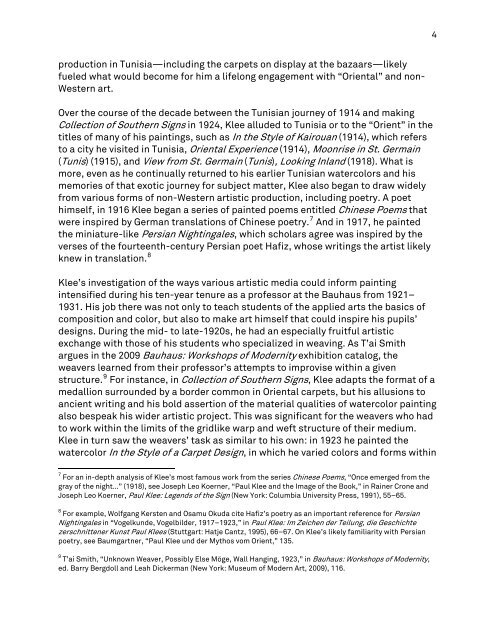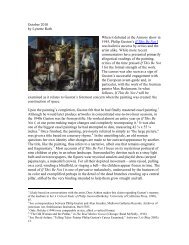Paul Klee, Zeichensammlung Südlich (Collection of Southern Signs ...
Paul Klee, Zeichensammlung Südlich (Collection of Southern Signs ...
Paul Klee, Zeichensammlung Südlich (Collection of Southern Signs ...
Create successful ePaper yourself
Turn your PDF publications into a flip-book with our unique Google optimized e-Paper software.
production in Tunisia—including the carpets on display at the bazaars—likely<br />
fueled what would become for him a lifelong engagement with “Oriental” and non-<br />
Western<br />
art.<br />
ly<br />
h-century Persian poet Hafiz, whose writings the artist likely<br />
new in translation. 8<br />
Over the course <strong>of</strong> the decade between the Tunisian journey <strong>of</strong> 1914 and making<br />
<strong>Collection</strong> <strong>of</strong> <strong>Southern</strong> <strong>Signs</strong> in 1924, <strong>Klee</strong> alluded to Tunisia or to the “Orient” in the<br />
titles <strong>of</strong> many <strong>of</strong> his paintings, such as In the Style <strong>of</strong> Kairouan (1914), which refers<br />
to a city he visited in Tunisia, Oriental Experience (1914), Moonrise in St. Germain<br />
(Tunis) (1915), and View from St. Germain (Tunis), Looking Inland (1918). What is<br />
more, even as he continually returned to his earlier Tunisian watercolors and his<br />
memories <strong>of</strong> that exotic journey for subject matter, <strong>Klee</strong> also began to draw wide<br />
from various forms <strong>of</strong> non-Western artistic production, including poetry. A poet<br />
himself, in 1916 <strong>Klee</strong> began a series <strong>of</strong> painted poems entitled Chinese Poems that<br />
were inspired by German translations <strong>of</strong> Chinese poetry. 7 And in 1917, he painted<br />
the miniature-like Persian Nightingales, which scholars agree was inspired by the<br />
verses <strong>of</strong> the fourteent<br />
k<br />
<strong>Klee</strong>’s investigation <strong>of</strong> the ways various artistic media could inform painting<br />
intensified during his ten-year tenure as a pr<strong>of</strong>essor at the Bauhaus from 1921–<br />
1931. His job there was not only to teach students <strong>of</strong> the applied arts the basics <strong>of</strong><br />
composition and color, but also to make art himself that could inspire his pupils’<br />
designs. During the mid- to late-1920s, he had an especially fruitful artistic<br />
exchange with those <strong>of</strong> his students who specialized in weaving. As T’ai Smith<br />
argues in the 2009 Bauhaus: Workshops <strong>of</strong> Modernity exhibition catalog, the<br />
weavers learned from their pr<strong>of</strong>essor’s attempts to improvise within a given<br />
structure. a<br />
ad<br />
.<br />
ithin<br />
9 For instance, in <strong>Collection</strong> <strong>of</strong> <strong>Southern</strong> <strong>Signs</strong>, <strong>Klee</strong> adapts the format <strong>of</strong><br />
medallion surrounded by a border common in Oriental carpets, but his allusions to<br />
ancient writing and his bold assertion <strong>of</strong> the material qualities <strong>of</strong> watercolor painting<br />
also bespeak his wider artistic project. This was significant for the weavers who h<br />
to work within the limits <strong>of</strong> the gridlike warp and weft structure <strong>of</strong> their medium<br />
<strong>Klee</strong> in turn saw the weavers’ task as similar to his own: in 1923 he painted the<br />
watercolor In the Style <strong>of</strong> a Carpet Design, in which he varied colors and forms w<br />
7 For an in-depth analysis <strong>of</strong> <strong>Klee</strong>’s most famous work from the series Chinese Poems, “Once emerged from the<br />
gray <strong>of</strong> the night…” (1918), see Joseph Leo Koerner, “<strong>Paul</strong> <strong>Klee</strong> and the Image <strong>of</strong> the Book,” in Rainer Crone and<br />
Joseph Leo Koerner, <strong>Paul</strong> <strong>Klee</strong>: Legends <strong>of</strong> the Sign (New York: Columbia University Press, 1991), 55–65.<br />
8 For example, Wolfgang Kersten and Osamu Okuda cite Hafiz’s poetry as an important reference for Persian<br />
Nightingales in “Vogelkunde, Vogelbilder, 1917–1923,” in <strong>Paul</strong> <strong>Klee</strong>: Im Zeichen der Teilung, die Geschichte<br />
zerschnittener Kunst <strong>Paul</strong> <strong>Klee</strong>s (Stuttgart: Hatje Cantz, 1995), 66–67. On <strong>Klee</strong>’s likely familiarity with Persian<br />
poetry, see Baumgartner, “<strong>Paul</strong> <strong>Klee</strong> und der Mythos vom Orient,” 135.<br />
9 T’ai Smith, “Unknown Weaver, Possibly Else Möge, Wall Hanging, 1923,” in Bauhaus: Workshops <strong>of</strong> Modernity,<br />
ed. Barry Bergdoll and Leah Dickerman (New York: Museum <strong>of</strong> Modern Art, 2009), 116.<br />
4




